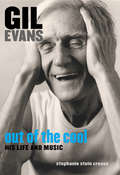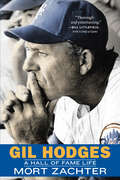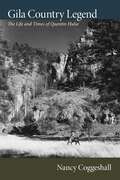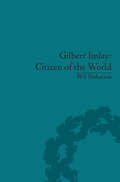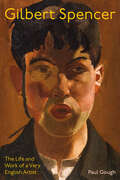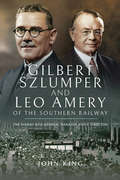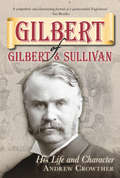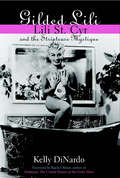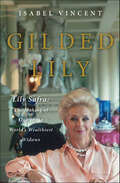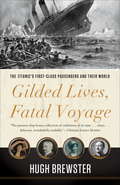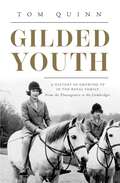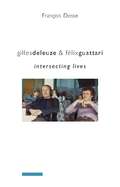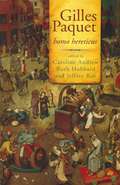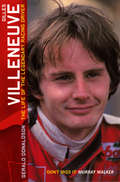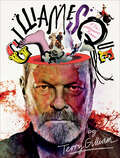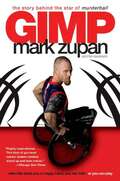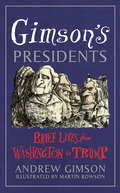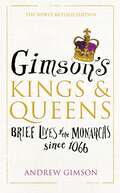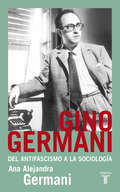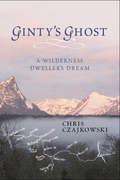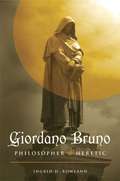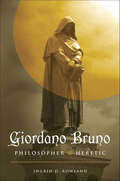- Table View
- List View
Gigolo
by Mr GoldenMeet Golden. He's gorgeous, charming, and very serious about his work. A jazz musician by day, by night he's an exclusive escort for glamorous modern women, paid in expensive dinners and fabulous clothes to service their every desire. These ladies work hard and play even harder. Take Miss Alpha, who thinks nothing of flying him over to New York at a moment's notice for an evening of fun in a bath full of champagne, or Ms Antoinette, who uses her bonuses to fund her Golden habit.But although Golden loves his life, working at the frontline of the female sexual revolution and hanging out with his fellow gigolos at the monthly boys only Dandy Trade Union meetings, there's also a bit of him that wonders whether he'll ever find Miss Right.Gigolo is the sexiest account yet of life as a high class escort, and a wonderfully warm and witty tribute to the joys of Noughties hedonism.Meet Golden. He's gorgeous, charming, and very serious about his work. A jazz musician by day, by night he's an exclusive escort for glamorous modern women, paid in expensive dinners and fabulous clothes to service their every desire. These ladies work hard and play even harder. Take Miss Alpha, who thinks nothing of flying him over to New York at a moment's notice for an evening of fun in a bath full of champagne, or Ms Antoinette, who uses her bonuses to fund her Golden habit. But although Golden loves his life, working at the frontline of the female sexual revolution and hanging out with his fellow gigolos at the monthly boys only Dandy Trade Union meetings, there's also a bit of him that wonders whether he'll ever find Miss Right.Gigolo is the sexiest account yet of life as a high class escort, and a wonderfully warm and witty tribute to the joys of Noughties hedonism.
Gil Evans: His Life and Music
by Stephanie Stein CreaseThe life (1912-1988) and career of Gil Evans paralleled and often foreshadowed the quickly changing world of jazz through the 20th century. Gil Evans: Out of the Cool is the comprehensive biography of a self-taught musician whom colleagues often regarded as a mentor. His innovative work as a composer, arranger, and bandleader--for Miles Davis, with whom he frequently collaborated over the course of four decades, and for his own ensembles--places him alongside Duke Ellington and Aaron Copland as one of the giants of American music. His unflagging creativity galvanized the most prominent jazz musicians in the world, both black and white. This biography traces Evans's early years: his first dance bands in California during the Depression; his life as a studio arranger in Hollywood; and his early work with Claude Thornhill, one of the most unusual bandleaders of the Big Band Era. After settling in New York City in 1946, Evans's basement apartment quickly became a meeting ground for musicians. The discussions that took place there among Miles Davis, Gerry Mulligan, John Lewis, and others resulted in the "Birth of the Cool" scores for the Miles Davis Nonet and, later on, for Evans's masterpieces with Davis: "Miles Ahead," "Porgy and Bess," and "Sketches of Spain." This replaces 1556524250.
Gil Hodges: A Hall of Fame Life
by Mort ZachterIn descriptions of athletes, the word “hero” is bandied about and liberally attached to players with outstanding statistics and championship rings. Gil Hodges: A Hall of Fame Life is the story of a man who epitomized heroism in its truest meaning, holding values and personal interactions to be of utmost importance throughout his life—on the diamond, as a marine in World War II, and in his personal and civic life. A New York City icon and, with the Brooklyn Dodgers, one of the finest first basemen of all time, Gil Hodges (1924–72) managed the Washington Senators and later the New York Mets, leading the 1969 “Miracle Mets” to a World Series championship. A beloved baseball star, Hodges was also an ethical figure whose sturdy values both on and off the field once prompted a Brooklyn priest to tell his congregation to “go home, and say a prayer for Gil Hodges” in order to snap him out of the worst batting slump of his career.Mort Zachter examines Hodges’s playing and managing days, but perhaps more important, he unearths his true heroism by emphasizing the impact that Hodges’s humanity had on those around him on a daily basis. Hodges was a witty man with a dry sense of humor, and his dignity and humble sacrifice sometimes masked a temper that made Joe Torre refer to him as the “Quiet Inferno.” The honesty and integrity that made him so popular to so many remained his defining elements. Firsthand interviews of the many soldiers, friends, family, former teammates, players, and managers who knew and respected Hodges bring the totality of his life into full view, providing a rounded appreciation for this great man and ballplayer.
Gila Country Legend: The Life and Times of Quentin Hulse
by Nancy CoggeshallIf there was ever a ring-tailed roarer of the backwoods of New Mexico, he was Quentin Hulse (1926-2002). Hulse lived and worked most of his life at the bottom of Canyon Creek in the Gila River country of southwestern New Mexico, but his reputation spread far and wide. His western image appeared on a tourist postcard and souvenir license plate in the 1950s. Footage of a lion hunt led by Hulse and his hounds appeared on the Men's Channel in 2005, three years after his passing.Hulse grew up primarily in western New Mexico when that ranch and mining country was still remote and raw. At the age of ten he witnessed a point-blank shooting, the culmination of an old-fashioned frontier feud. He followed his parents between mines and towns until his father established a ranch at Canyon Creek. While serving in the navy during World War II, he landed on the bloody beach at Okinawa. After returning from the war, he was shot in a bar near Silver City during a night of carousing.Hulse was most at home in the rugged Gila Wilderness, in which he ranched and guided for fifty years. With compassion and nuance, Nancy Coggeshall tells the compelling biography of a unique western rancher constantly adjusting to the inroads of modernity into his traditional way of life. Drawing on oral history, archival sources, and her personal association with Hulse and the Gila, she brings this unique westerner, and New Mexican, to life.
Gilbert Imlay: Citizen of the World
by Wil VerhoevenA biography of the American Gilbert Imlay (c 1754 - c 1828), revolutionary war veteran - and infamous lover of Mary Wollstonecraft. It also highlights how Imlay unwittingly acted as an intermediary between figures of greater significance, whose ideas, ambitions and schemes he frequently borrowed and disseminated across the Atlantic and continents.
Gilbert Spencer: The Life and Work of a Very English Artist
by Sacha Llewellyn Amanda Bradley PetitgasThe first biography of Gilbert Spencer, recounting the life and career of a long-overlooked twentieth-century British artist Gilbert Spencer (1892–1979) was a British painter, muralist, illustrator, teacher, and writer whose career spanned more than six decades. Recognised during his lifetime as one of the leading artists of his generation, his reputation has long been overshadowed by his more famous brother, Stanley. Yet Spencer’s fascination with landscape and his ability to capture everyday life in rural England led to the creation of some of the most poignant artworks of the interwar period. Drawing on a newly discovered archive of personal letters, notebooks, and diaries, this illustrated biography tells Spencer’s story for the first time. Bringing together his major paintings, drawings and illustrations, many never before seen, the book greatly expands our understanding of Spencer. It reassesses his status within twentieth-century British modernism and the revival of the landscape tradition, as well as the important role he played in the reinvigoration of public mural painting. Spencer is also reappraised as one of the most successful art teachers of his time, and his extensive influence on the lives and careers of many twentieth-century artists is explored in detail.
Gilbert Szlumper and Leo Amery of the Southern Railway: The Diaries of a General Manager and a Director
by John KingVery few diaries of directors and senior managers of the Big Four railways have survived to enter the public domain. There are, however, two notable Southern Railway diarists whose records have been available in archives for some years, but have been largely ignored by historians; Southern Railway General Manager Gilbert Szlumper and Director Leopold Amery. Their remarkable diaries are addressed in this insightful book, which gives a slightly different view of the company in contrast to the almost sanitized histories by some writers.The surviving diaries of Szlumper are far from complete. They begin in 1936 and continue into the war years, but there are several gaps. Throughout, Szlumper comments on individuals and developments, revealing little-known facts and the circumstances that meant he could never truly achieve his potential. Formally retiring in 1942, he died in 1969, after which his diaries entered the public domain.Leopold Amery was director of the Southern Railway from 1932. A Birmingham Member of Parliament for many years, he was a statesman of some stature, his high offices including Secretary of State for the Colonies in the 1920s. In his autobiography, Amery writes very little on the railway, although he does comment on its family atmosphere. His diaries, which are in the public domain in a Cambridge University archive, have been published in two volumes but Amerys fascinating business activities were omitted by the publisher, and like Szlumper he comments on individuals and developments.The diary information of these two exceptional men has been supplemented by information from the railway, state archives and other sources, and many of the photographs have never been published before.
Gilbert of Gilbert and Sullivan: His Life and Character
by Andrew CrowtherThe author of The Pirates of Penzance, The Mikado, HMS Pinafore and the other great Savoy libretti, W S Gilbert, witty, caustic and disrespectful, was one of the celebrities of the late Victorian age. In his time he had been many things: journalist, theatre critic, cartoonist, comic poet, stage director, writer of short stories, dramatist. A political satire he wrote was banned by the Lord Chamberlain at the personal insistence of the Prince of Wales. He wrote the most brilliantly inventive plays of his time. With Arthur Sullivan he wrote comic operas that defined the age. He became richer and more famous than he could have imagined, but at the price of his artistic freedom. This is the story of an angry and quarrelsome man, discontented with himself and the age he lived in, raging at life’s absurdities and laughing at them. In this book his glorious, contradictory character is explored and brought vividly to life.
Gilded Lili
by Kelly DinardoBlond and beautiful, Lili St. Cyr shimmied across the country's nightclubs as one of the century's great sirens. She inspired future femme fatales including Marilyn Monroe, Madonna and Dita Von Teese. She helped cultivate the modern-day impression of striptease. And, with stage routines featuring themes from fantasy, history and literature, she scandalized and seduced millions, influencing pop culture for decades.Gilded Lili: Lili St. Cyr and the Striptease Mystique explores the life of the last real queen of burlesque. Born into a poor family, abandoned by her parents, and raised by her grandmother, she used her ambition, beauty, and charm to escape her small-town life. Upon becoming the top burlesque dancer of her era, she amassed legions of famous fans, including Betty Grable, Frank Sinatra, Ronald Reagan, and Humphrey Bogart. During her reign, one reporter called her "the rich man's Gypsy Rose Lee" and Marilyn Monroe took cues from her acts. After she retired, Mike Wallace wrote that his television interview with her remained one of the most fascinating he had ever conducted.The private Lili was considerably more troubled, however. Despite being married six times, Lili found love elusive; she was involved in affairs with wealthy businessmen and rumored to have dalliances with celebrities including Orson Welles, Victor Mature and Yul Brynner. She had as many as ten abortions, attempted suicide several times, and became reliant on sleeping pills and, ultimately, heroin.A searing look at American sexuality in the twentieth century, Gilded Lili immortalizes the legend with verve and grace. Lili's era - which see-sawed between McCarthyism and puritanical humor - is presented with vibrancy, intelligence, and commentary on the ever-changing dynamics between sex and commerce. Based on exhaustive research and filled with rare photographs, Gilded Lili reveals a portrait of a woman who made the century sizzle.
Gilded Lily: Lily Safra: The Making of One of the World's Wealthiest Widows
by Isabel VincentThe mesmerizing biography of one of the world's richest, most intriguing women—philanthropist and socialite Lily SafraIn the early morning of December 3, 1999, Lily Safra stood shivering in her nightgown on the grounds outside her sumptuous Monte Carlo penthouse where, just hours before, her fourth husband, reclusive billionaire Edmond Safra, died in a fire. An American nurse employed by the Safra family was eventually convicted of the arson death. Overnight, Lily became one of the wealthiest widows in the world.The Brazilian-born Lily Safra was no stranger to tragedy. In 1969, her second husband, the Brazilian multimillionaire Alfredo Monteverde, died from two gunshots to the chest. The Brazilian authorities ruled it a suicide. In 1989, her beloved eldest son and four-year-old grandson died in a car accident. But just who is Lily Safra? Despite having become a fixture in society columns for her generous charity work and lavish parties, the elegant and enigmatic widow has remained in the background.Gilded Lily tells Lily Safra's story for the first time. Using archival sources, court documents, and interviews with childhood friends and former employees in South America, investigative journalist Isabel Vincent chronicle's Safra's rise from humble origins in Brazil to fabled wealth in London, New York, and Monaco.
Gilded Lives, Fatal Voyage
by Hugh BrewsterGilded Lives, Fatal Voyage takes us behind the paneled doors of the Titanic's elegant private suites to present compelling, memorable portraits of her most notable passengers. The intimate atmosphere onboard history's most famous ship is recreated as never before. The Titanic has often been called "an exquisite microcosm of the Edwardian era," but until now, her story has not been presented as such. In Gilded Lives, Fatal Voyage, historian Hugh Brewster seamlessly interweaves personal narratives of the lost liner's most fascinating people with a haunting account of the fateful maiden crossing. Employing scrupulous research and featuring 100 rarely-seen photographs, he accurately depicts the ship's brief life and tragic denouement, presenting the very latest thinking on everything from when and how the lifeboats were loaded to the last tune played by the orchestra. Yet here too is a convincing evocation of the table talk at the famous Widener dinner party held in the Ritz Restaurant on the last night. And here we also experience the rustle of elegant undergarments as first-class ladies proceed down the grand staircase in their soigné evening gowns, some of them designed by Lady Duff Gordon, the celebrated couterière, who was also on board. Another well-known passenger was the artist Frank Millet, who led an astonishing life that seemed to encapsulate America's Gilded Age--from serving as a drummer boy in the Civil War to being the man who made Chicago's White City white for the 1893 World Exposition. His traveling companion Major Archibald Butt was President Taft's closest aide and was returning home for a grueling fall election campaign that his boss was expected to lose. Today, both of these once-famous men are almost forgotten, but their ship-mate Margaret Tobin Brown lives on as "the Unsinkable Molly Brown," a name that she was never called during her lifetime. Millionaires John Jacob Astor and Benjamin Guggenheim, writer Helen Churchill Candee, movie actress Dorothy Gibson, aristocrat Noelle, the Countess of Rothes, and a host of other travelers on this fateful crossing are also vividly brought to life within these pages. Through them, we gain insight into the arts, politics, culture, and sexual mores of a world both distant and near to our own. And with them, we gather on the Titanic's sloping deck on that cold, starlit night and observe their all-too-human reactions as the disaster unfolds. More than ever, we ask ourselves, "What would we have done?"
Gilded Youth: A History of Growing Up in the Royal Family: From the Tudors to the Cambridges
by Tom QuinnA colorful, fascinating look at growing up in the royal family over the centuries, from the Plantagenets and Tudors to the Windsors and Cambridges.For as long as the British royal family has existed, their children have been brought up in ways that seem bizarre and eccentric to the rest of us—the royal family&’s obsession with making their children tough and independent as early as possible, often by delegating their parental duties to staff, goes back centuries. Gilded Youth looks at centuries of growing up aristocratic and royal—from Edward VII smashing up his schoolroom to Prince Andrew peeing on a stable lad&’s shoes; from Princess Margaret putting horse manure in a footman&’s pockets to Diana Spencer wearing crop tops, kissing a local village boy, and drinking cider in a bus shelter; from a teenage Prince Harry throwing up in the street to Prince William becoming completely obsessed with doing the right thing regardless of the feelings of his younger brother. Even Queen Elizabeth herself reacted oddly to her upbringing, becoming in many ways obsessively compulsive—as a child she insisted her shoes should always be positioned in the same place, her lunch set out exactly the same way each day, and that for tea she have jam pennies (small rounds of bread and jam), which she was still eating every afternoon into her nineties. The younger generation seem to insist they want a normal or ordinary upbringing for their children—because that goes down well with the public—but this is just window dressing. Gilded Youth looks at how, when it comes to their children, the British royal family is still behaving much as they did in the past.
Gilles Deleuze and Félix Guattari: Intersecting Lives
by Deborah Glassman Francois DosseIn May 1968, Gilles Deleuze was an established philosopher teaching at the innovative Vincennes University, just outside of Paris. Félix Guattari was a political militant and the director of an unusual psychiatric clinic at La Borde. Their meeting was quite unlikely, yet the two were introduced in an arranged encounter of epic consequence. From that moment on, Deleuze and Guattari engaged in a surprising, productive partnership, collaborating on several groundbreaking works, including Anti-Oedipus, What Is Philosophy and A Thousand Plateaus. François Dosse, a prominent French intellectual known for his work on the Annales School, structuralism, and biographies of the pivotal intellectuals Paul Ricoeur, Pierre Chaunu, and Michel de Certeau, examines the prolific if improbable relationship between two men of distinct and differing sensibilities. Drawing on unpublished archives and hundreds of personal interviews, Dosse elucidates a collaboration that lasted more than two decades, underscoring the role that family and history --particularly the turbulent time of May 1968 --play in their monumental work. He also takes the measure of Deleuze and Guattari's posthumous fortunes and the impact of their thought on intellectual, academic, and professional circles.
Gilles Deleuze and Félix Guattari: Intersecting Lives (European Perspectives: A Series in Social Thought and Cultural Criticism)
by Francois DosseIn May 1968, Gilles Deleuze was an established philosopher teaching at the innovative Vincennes University, just outside of Paris. Félix Guattari was a political militant and the director of an unusual psychiatric clinic at La Borde. Their meeting was quite unlikely, yet the two were introduced in an arranged encounter of epic consequence. From that moment on, Deleuze and Guattari engaged in a surprising, productive partnership, collaborating on several groundbreaking works, including Anti-Oedipus, What Is Philosophy? and A Thousand Plateaus.François Dosse, a prominent French intellectual known for his work on the Annales School, structuralism, and biographies of the pivotal intellectuals Paul Ricoeur, Pierre Chaunu, and Michel de Certeau, examines the prolific if improbable relationship between two men of distinct and differing sensibilities. Drawing on unpublished archives and hundreds of personal interviews, Dosse elucidates a collaboration that lasted more than two decades, underscoring the role that family and history-particularly the turbulent time of May 1968-play in their monumental work. He also takes the measure of Deleuze and Guattari's posthumous fortunes and the impact of their thought on intellectual, academic, and professional circles.
Gilles Paquet: Homo hereticus (Governance Series)
by Andrew, Caroline; Hubbard, Ruth; Roy, JeffreyThis volume explores and contextualizes the contributions of Gilles Paquet as a social scientist. A quintessential public intellectual, Gilles Paquet's long and multifaceted career has shown him to be a thinker of significant power and creativity. This self-described "homo hereticus"--always critical and sometimes controversial--has influenced scholars and policy makers in Canada and around the globe. The contributors reveal how his assessments of economics, politics, public administration, and education have stirred their minds and helped them make sense of the world around them. The volume also provides comments on Paquet's vision of governance, touching on concepts of which he has made extensive use: meso-analysis, social learning, and moral contracts.
Gilles Villeneuve: The Life Of The Legendary Racing Driver (Motor Sport Ser.)
by Gerald DonaldsonGilles Villeneuve became a legend in his own time, a driver whose skill and daring personified the ideals of Grand Prix racing, the pinnacle of motor sport.With his flamboyantly aggressive, press-on-regardless style in his scarlet Ferrari, he captured the imagination of a vast international audience as no other driver has in recent times.
Gilliamesque: A Pre-posthumous Memoir
by Terry GilliamThe screenwriter, innovative animator, highly acclaimed visionary film director, and only non-British member of Monty Python offers an intimate glimpse into his world in this fascinating memoir illustrated with hand-drawn sketches, notes, and memorabilia from his personal archive.From his no-frills childhood in the icy wastes of Minnesota, to some of the hottest water Hollywood had to offer, via the cutting edge of 1960s and ’70s counter-culture in New York, L.A. and London, Terry Gilliam’s life has been as vivid, entertaining and unorthodox as one of his films.Telling his story for the first time, the director of Time Bandits, Brazil, The Adventures of Baron Munchausen, The Fisher King, 12 Monkeys, and Fear & Loathing in Las Vegas—not to mention co-founder of Monty Python’s Flying Circus—recalls his life so far. Packed with never-before-seen artwork, photographs and commentary, Gilliamesque blends the visual and the verbal with scabrous wit and fascinating insight.Gilliam’s “pre-posthumous memoir” also features a cast of amazing supporting characters—George Harrison, Robin Williams, Jeff Bridges, Robert De Niro, Brad Pitt, Uma Thurman, Johnny Depp, Heath Ledger and all of the fellow Pythons—as well as cameo appearances from some of the heaviest cultural hitters of modern times, from Woody Allen to Frank Zappa, Gloria Steinem to Robert Crumb, Richard Nixon to Hunter S. Thompson. Gilliam’s encounters with the great and the not-so-good are revealing, funny, and hugely entertaining.This book is an unrestrained look into a unique creative mind and an incomparable portrait of late twentieth-century popular culture.
Gimp: The Story Behind The Star Of Murderball
by Tim Swanson Mark ZupanCollege soccer star Mark Zupan had been out drinking one night and had passed out in the back of his best friend's pickup truck when his friend got in the driver's seat, decided to take the truck for a spin, and accidentally crashed it. Thrown into a canal and stuck in frigid water for fourteen hours, Mark was finally rescued and learned soon after that he'd broken his neck. He'd most likely be a quadriplegic and spend the rest of his life in a wheelchair, doctors told him. At first Mark's only goal was to walk again. When that proved impossible, he fell into the depths of anger and despair, retreating from the world and the people closest to him. But love, friendship, and a new sport, quad rugby (a.k.a. "murderball"), helped Mark create a new existence that's truly exceptional. Gimp, the no-holds-barred memoir of a Paralympic athlete and the star of the Academy Award–nominated documentary Murderball, is an inspiring, defiant, and revealing celebration of spirit and will that confounds readers' prejudices by offering proof that a guy in a chair can still do amazing things: have sex with his girlfriend, party with his friends . . . even crowd-surf at Pearl Jam shows.
Gimson's Presidents: Brief Lives from Washington to Trump
by Andrew Gimson'Crisp and witty' Charles Moore, Spectator'A brilliant survey of the occupants of the Oval Office' Daniel Johnson, Article'Witty and succinct with splendid caricatures' Tibor Fischer, CriticA spirited and entertaining aide-memoire offering 44 short, fascinating accounts of each president, from George Washington and Abraham Lincoln to Barack Obama and Donald Trump, bringing the United States' political history to life as never before.Who can name the eight presidents before Lincoln, or the eight presidents after him? Historians tend to shed light on just a handful of leaders: Washington, Jefferson, Lincoln, and perhaps half a dozen others within living memory, leaving at least 30 holders of office if not in total darkness, then at least in deep shadow.Helping to bring these forgotten figures into the light, Andrew Gimson's illuminating accounts are accompanied by sketches from Guardian sartirical cartoonist, Martin Rowson, making this the perfect gift for all lovers of history and politics - the experienced and the novice, the serious and the silly.The Sunday Times bestselling Gimson's Prime Ministers and Gimson's Kings & Queens are also available.
Gimson’s Kings and Queens: Brief Lives of the Forty Monarchs since 1066
by Andrew GimsonNEWLY REVISED AND UPDATEDA book for all lovers of history: the experienced and the novice, the serious and the silly.Gimson's Kings and Queens whirls us through the lives of our monarchs - from 1066 and William the Conqueror right up to Queen Elizabeth II and the present-day - to tell a tale of bastardy, courage, conquest, brutality, vanity, vulgarity, corruption, anarchy, absenteeism, piety, nobility, divorce, execution, civil war, madness, magnificence, profligacy, frugality, philately, abdication, dutifulness, family breakdown and family recovery.Written in Andrew Gimson's inimitable style, and illustrated by Martin Rowson, this is both a primer and a refresher for anyone who can't quite remember which were the good and bad Edwards or Henrys, or why so-and-so succeeded to the throne rather than his second cousin.'The most entertaining and instructive book on the English monarchy you will ever read' Daily Telegraph
Gino Germani. Del antifascismo a la sociología: Gino Germani 1911-1979
by Ana Alejandra GermaniDocumentos inéditos y testimonios de los intelectuales que protagonizaron el movimiento cultural de los años cuarenta, cincuenta y sesenta contribuyen a iluminar la figura y la obra de Gino Germani que ha dejado huellas indelebles en el campo de estudio de la sociedad argentina. Documentos inéditos y testimonios de los intelectuales que protagonizaron el movimiento cultural de los años cuarenta, cincuenta y sesenta contribuyen a iluminar la figura y la obra de este científico, Gino Germani, que ha dejado huellas indelebles en el campo de estudio de la sociedad argentina. Desde el joven que abandonó su Italia natal huyendo de la persecución fascista hasta el profesional internacionalmente reconocido que emprende otra vez el camino del exilio -esta vez al mundo académico estadounidense-, la vida de Gino Germani puede concebirse como la de un auténtico liberal en lucha permanente contra toda forma de totalitarismo. El fundador de la Sociología científica en la Argentina estaba convencido de que una sociedad democrática era condición sine qua non para el pleno desarrollo de la ciencia. Y Germani era un científico cabal, que bregó sin descanso por una Sociología basada en fundamentos empíricos y alejada de cualquier forma de retórica. Vivió y llevó a cabo su actividad profesional en la Argentina durante uno de los períodos más fecundos en el desarrollo de las ciencias sociales locales y fue protagonista indiscutido de ese proceso, generador de debates vitales que siguen siendo punto de referencia entre quienes se dedican a esas disciplinas. Ana Germani ha escrito una minuciosa biografía intelectual que reconstruye el clima de esa época convulsionada y prolífica.
Ginsberg: A Biography
by Barry MilesBarry Miles has accounted the life of one of the most extraordinary poets. Drawing on his long literary association with Ginsberg, as well as on the poet's journals and correspondence, he presents an account of a controversial life.
Ginty's Ghost
by Chris CzajkowskiAfter nearly three decades of wilderness dwelling far from neighbours and roads, with the nearest community accessible only via float plane or days of hiking, Czajkowski purchases a derelict homestead with rough road access at Ginty Creek, an hour's drive south of Anahim Lake. Although the property is mostly swamp and the packrat-infested buildings are uninhabitable, the location affords beautiful views and abundant wildlife-and the asking price is within her budget.Ginty Creek was named for Ginty Paul, the eccentric recluse who had previously owned the property. Some locals remember Ginty affectionately, while others feared her volatile temper or refused to step into her house for fear of being served "chicken poop tea." She had an open-door policy to all of her animals-the chickens would sleep with her and the bedroom doubled as a maternity ward for dogs, cats, goats and sheep. Intrigued by the stories,Czajkowski tracks down a pile of Ginty's letters and documents. These, combined with many fond, bitter and bizarre anecdotes gleaned from interviews with area residents, are all woven into the account.As Czajkowski chronicles the many challenges of settling into her new home, it becomes clear that she and Ginty have more than just a piece of land in common. They also share a spirit of independence and resourcefulness, as well as an unwavering desire for a solitary life immersed in the spectacular landscapes of British Columbia.
Giordano Bruno: Philosopher / Heretic
by Ingrid D. RowlandGiordano Bruno is one of the great figures of early modern Europe, and one of the least understood. Ingrid D. Rowland's pathbreaking life of Bruno establishes him once and for all as a peer of Erasmus, Shakespeare, and Galileo, a thinker whose vision of the world prefigures ours. By the time Bruno was burned at the stake as a heretic in 1600 on Rome's Campo dei Fiori, he had taught in Naples, Rome, Venice, Geneva, France, England, Germany, and the & magic Prague of Emperor Rudolph II. His powers of memory and his provocative ideas about the infinity of the universe had attracted the attention of the pope, Queen Elizabeth--and the Inquisition, which condemned him to death in Rome as part of a year long jubilee. Writing with great verve and sympathy for her protagonist, Rowland traces Bruno's wanderings through a sixteenth-century Europe where every certainty of religion and philosophy had been called into question and shows him valiantly defending his ideas (and his right to maintain them) to the very end. An incisive, independent thinker just when natural philosophy was transformed into modern science, he was also a writer of sublime talent. His eloquence and his courage inspired thinkers across Europe, finding expression in the work of Shakespeare and Galileo. Giordano Bruno allows us to encounter a legendary European figure as if for the first time.
Giordano Bruno: Philosopher/Heretic
by Ingrid D. Rowland“Ingrid D. Rowland brings before us today the pieces of an extraordinary sixteenth-century life . . . This is intellectual biography at its best.” —Peter N. Miller, The New RepublicGiordano Bruno is one of the great figures of early modern Europe, and one of the least understood. Ingrid D. Rowland's pathbreaking life of Bruno establishes him once and for all as a peer of Erasmus, Shakespeare, and Galileo, a thinker whose vision of the world prefigures ours.By the time Bruno was burned at the stake as a heretic in 1600 on Rome's Campo dei Fiori, he had taught in Naples, Rome, Venice, Geneva, France, England, Germany, and the “magic Prague” of Emperor Rudolph II. His powers of memory and his provocative ideas about the infinity of the universe had attracted the attention of the pope, Queen Elizabeth—and the Inquisition, which condemned him to death in Rome as part of a yearlong jubilee.Writing with great verve and sympathy for her protagonist, Rowland traces Bruno's wanderings through a sixteenth-century Europe where every certainty of religion and philosophy had been called into question and shows him valiantly defending his ideas (and his right to maintain them) to the very end. An incisive, independent thinker just when natural philosophy was transformed into modern science, he was also a writer of sublime talent. His eloquence and his courage inspired thinkers across Europe, finding expression in the work of Shakespeare and Galileo.Giordano Bruno allows us to encounter a legendary European figure as if for the first time.“A loving and thoughtful account of [Bruno’s] life and thought, satires and sonnets, dialogues and lesson plans, vagabond days and star-spangled nights.” —John Leonard, Harper’s

